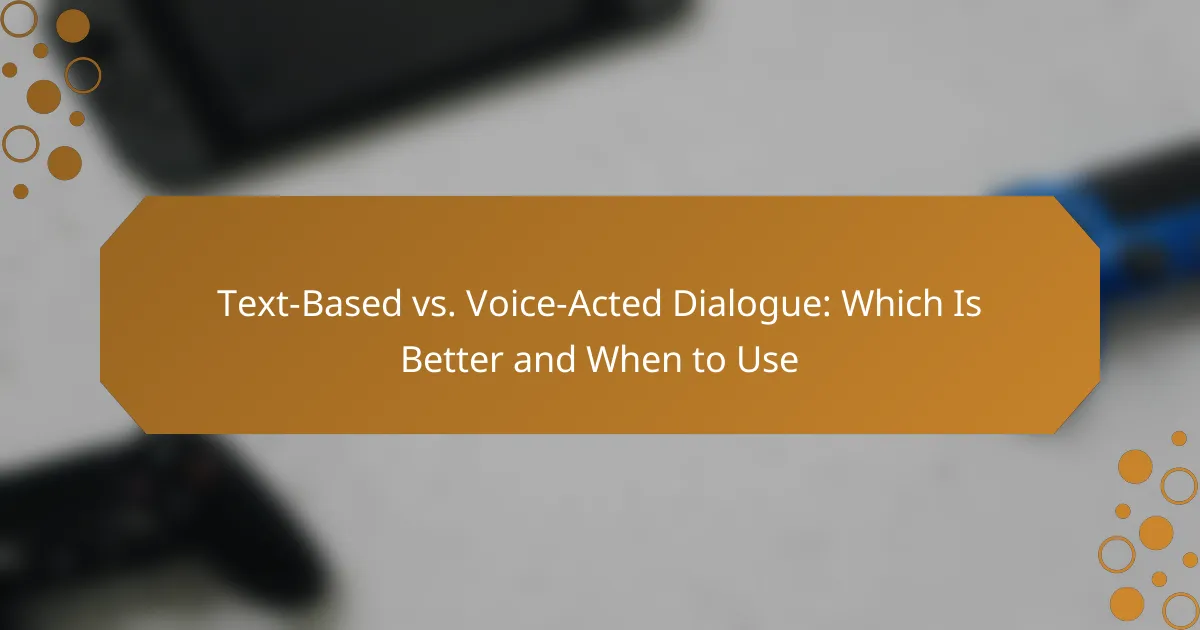When it comes to storytelling, the choice between text-based and voice-acted dialogue can significantly impact the audience’s experience. Text-based dialogue excels in clarity and accessibility, making it ideal for situations where quick comprehension is essential. In contrast, voice-acted dialogue brings emotional depth and immersion, allowing creators to convey nuances that text alone may struggle to express. Understanding when to use each format can enhance the effectiveness of the narrative.
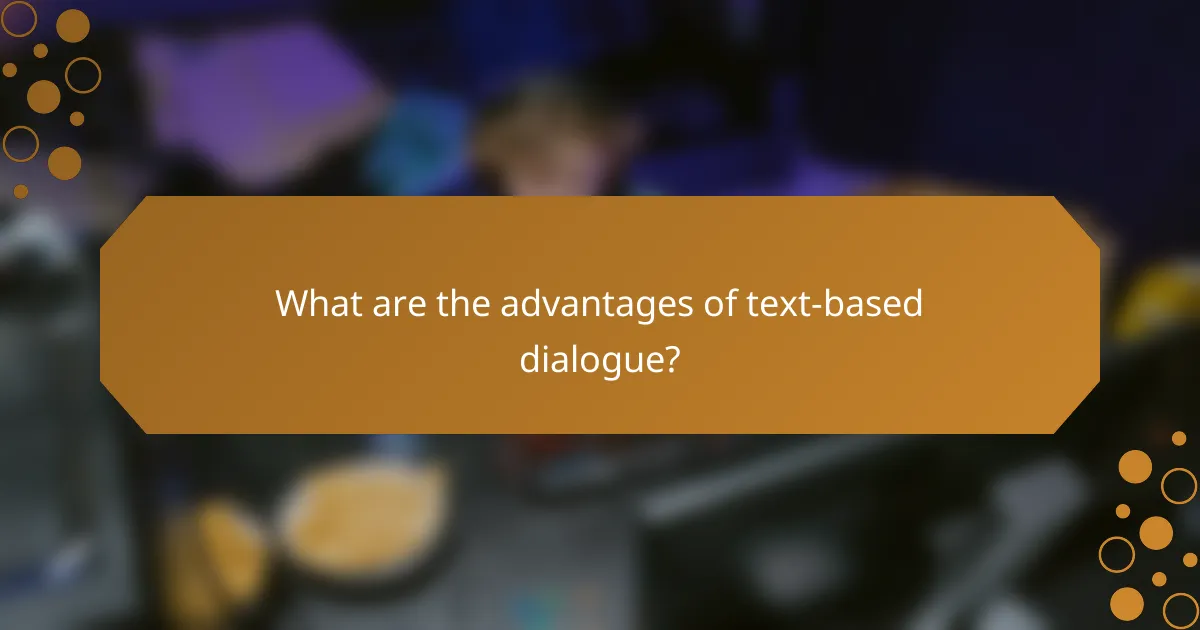
What are the advantages of text-based dialogue?
Text-based dialogue offers several advantages, particularly in terms of cost, flexibility, and accessibility. It allows creators to convey information clearly while enabling easy modifications and broader audience reach.
Cost-effective production
Producing text-based dialogue is generally more affordable than voice-acted alternatives. It eliminates costs associated with hiring voice actors, studio time, and audio editing, making it a suitable choice for projects with limited budgets.
For example, indie game developers or small businesses can create engaging text dialogues without incurring high expenses, allowing them to allocate resources to other critical areas of their projects.
Easy editing and updates
Text-based dialogue can be easily edited or updated, which is crucial for projects that require frequent changes. Modifying a line of text takes minimal time compared to re-recording audio, making it efficient for iterative development.
This flexibility is particularly beneficial in software development, where user feedback may necessitate quick adjustments to dialogue. Developers can swiftly implement changes without significant delays in production timelines.
Accessible for diverse audiences
Text-based dialogue enhances accessibility for a wider range of audiences, including those who are deaf or hard of hearing. It allows users to engage with content without relying on audio, ensuring inclusivity.
Moreover, text can be easily translated into multiple languages, broadening the reach of the content. This is especially important for global applications where catering to diverse linguistic backgrounds is essential for user engagement.
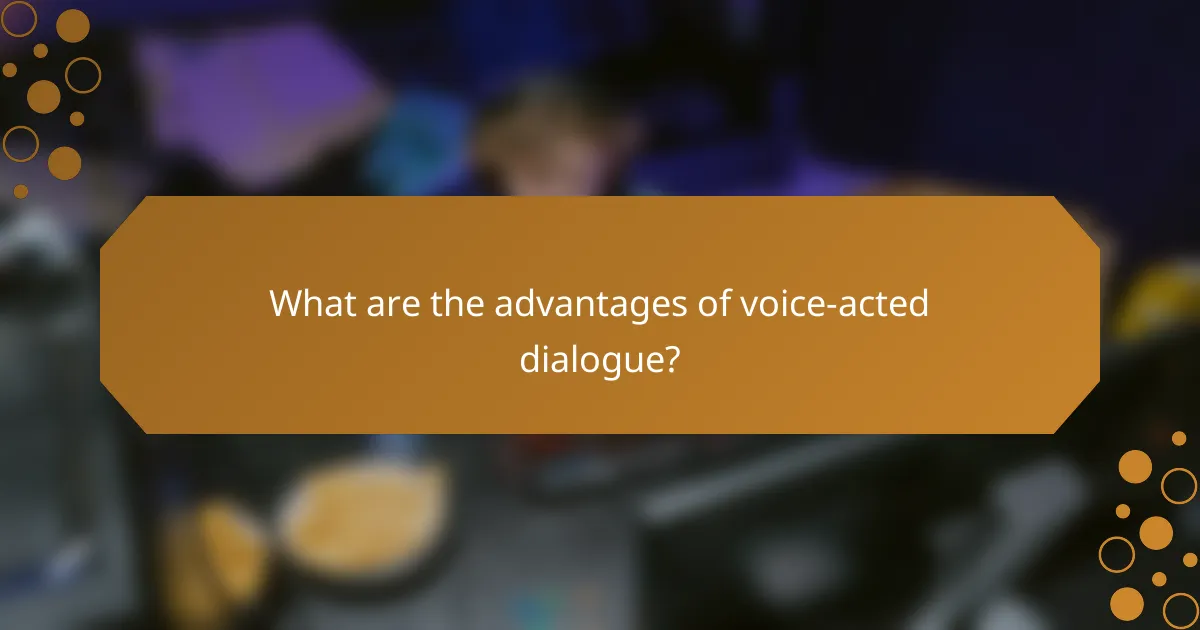
What are the advantages of voice-acted dialogue?
Voice-acted dialogue offers several advantages, including enhanced emotional depth and a more immersive experience for the audience. By incorporating voice acting, creators can convey nuances in tone and emotion that text alone may struggle to express.
Enhanced emotional engagement
Voice-acted dialogue significantly boosts emotional engagement by allowing actors to infuse their performances with passion and subtlety. Listeners can pick up on inflections, pauses, and variations in pitch that convey feelings such as joy, sadness, or tension, making the narrative more relatable.
For example, a character’s heartfelt confession delivered with a trembling voice can resonate more deeply than the same words presented in text. This emotional connection can lead to a stronger attachment to the characters and story.
Improved character immersion
Voice acting enhances character immersion by providing distinct vocal identities for each character, helping audiences differentiate between them easily. Unique voice traits can reflect a character’s personality, background, or emotional state, enriching the storytelling experience.
In games or films, hearing a character’s voice can create a sense of familiarity and attachment, making players or viewers feel as if they are part of the story. This level of immersion is often difficult to achieve with text alone.
Better for auditory learners
Voice-acted dialogue caters to auditory learners who grasp information more effectively through listening. For these individuals, hearing dialogue can enhance comprehension and retention of the material, making it easier to follow complex narratives.
In educational contexts, incorporating voice acting into lessons can help engage students who may struggle with traditional text-based formats. This approach can foster a more inclusive learning environment by accommodating diverse learning styles.

When should I use text-based dialogue?
Text-based dialogue is ideal when clarity and accessibility are paramount. It allows users to read at their own pace, making it suitable for various contexts, especially where quick comprehension is needed.
For instructional content
Text-based dialogue excels in instructional content, such as tutorials or guides. It provides clear, step-by-step information that users can easily reference without missing critical details. For example, a cooking recipe or software manual benefits from written instructions that users can follow at their own speed.
Additionally, text allows for the inclusion of diagrams, screenshots, or links that enhance understanding. This format is particularly useful in educational settings where learners may need to revisit material multiple times.
When budget is limited
Text-based dialogue is often more cost-effective than voice-acted dialogue. Producing voice content involves hiring voice actors, sound engineers, and potentially longer production times, which can significantly increase costs. In contrast, text can be created and edited quickly, reducing overall expenses.
For projects with tight budgets, consider using text for initial releases or MVPs (Minimum Viable Products). This approach allows for user feedback before investing in more expensive voice options.
For quick updates
When rapid updates are necessary, text-based dialogue is the preferred choice. It allows for immediate changes without the need for re-recording audio, which can be time-consuming. For instance, updating a software feature description can be done in minutes with text, while voice updates may take hours or days.
Using text also enables easy localization and translation, making it simpler to adapt content for different languages or regions. This flexibility is crucial for businesses operating in diverse markets.
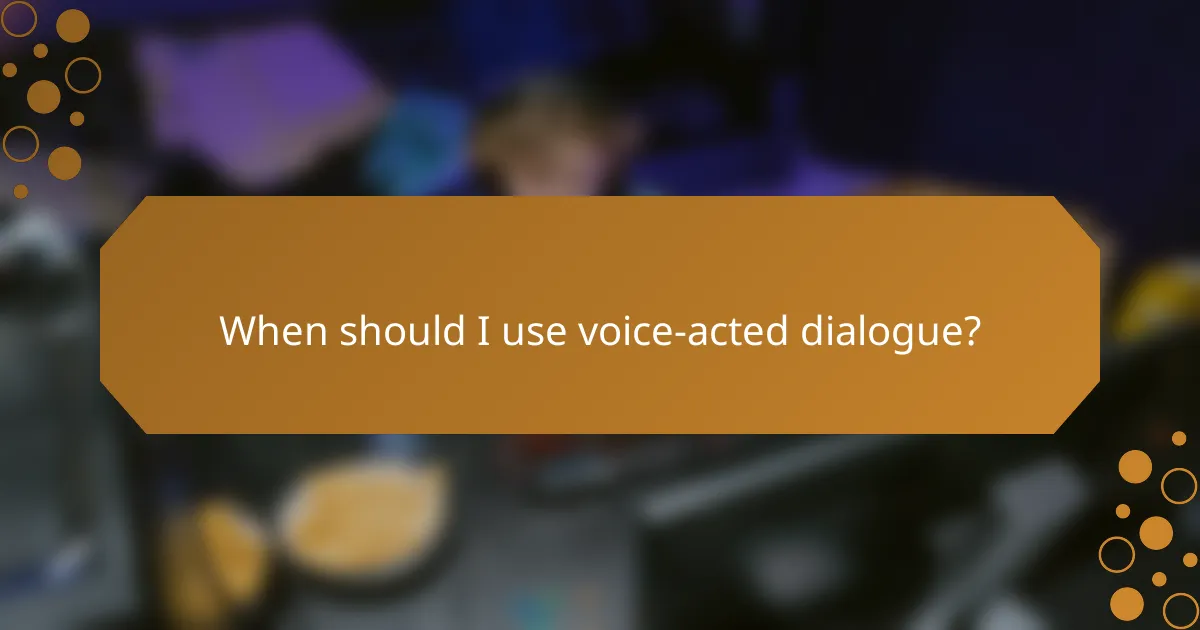
When should I use voice-acted dialogue?
Voice-acted dialogue is best used in scenarios where emotional engagement and character immersion are priorities. It enhances storytelling by bringing characters to life and can improve user experience, especially in interactive formats.
For storytelling experiences
In storytelling, voice-acted dialogue can significantly enhance the narrative by conveying emotions and personality traits that text alone may not capture. For example, a character’s tone can indicate their mood, making the story more relatable and immersive. Consider using voice acting in genres like fantasy or drama, where character depth is essential.
When implementing voice-acted dialogue, ensure that the voice actors align with the characters’ personalities and the overall tone of the story. This alignment helps maintain coherence and keeps the audience engaged throughout the experience.
When targeting mobile users
Voice-acted dialogue is particularly effective for mobile users, as it allows for hands-free interaction and can enhance multitasking. Users can listen to dialogue while performing other tasks, making it a convenient option for mobile games and apps. This can lead to increased user retention and satisfaction.
To optimize for mobile, keep voice clips short and engaging. Aim for dialogue that lasts between 10 to 30 seconds to maintain user attention without overwhelming them. Consider offering options for users to adjust volume or toggle voice acting on and off based on their preferences.
For games and interactive media
In games and interactive media, voice-acted dialogue can create a more dynamic and engaging experience. It allows players to connect with characters on a deeper level, enhancing their emotional investment in the game. This is especially true in role-playing games (RPGs) where character development is crucial.
When incorporating voice acting, balance it with gameplay elements. Avoid excessive dialogue that can disrupt pacing or gameplay flow. A good practice is to use voice acting for key moments or decisions, ensuring that players remain engaged without feeling bogged down by constant narration.
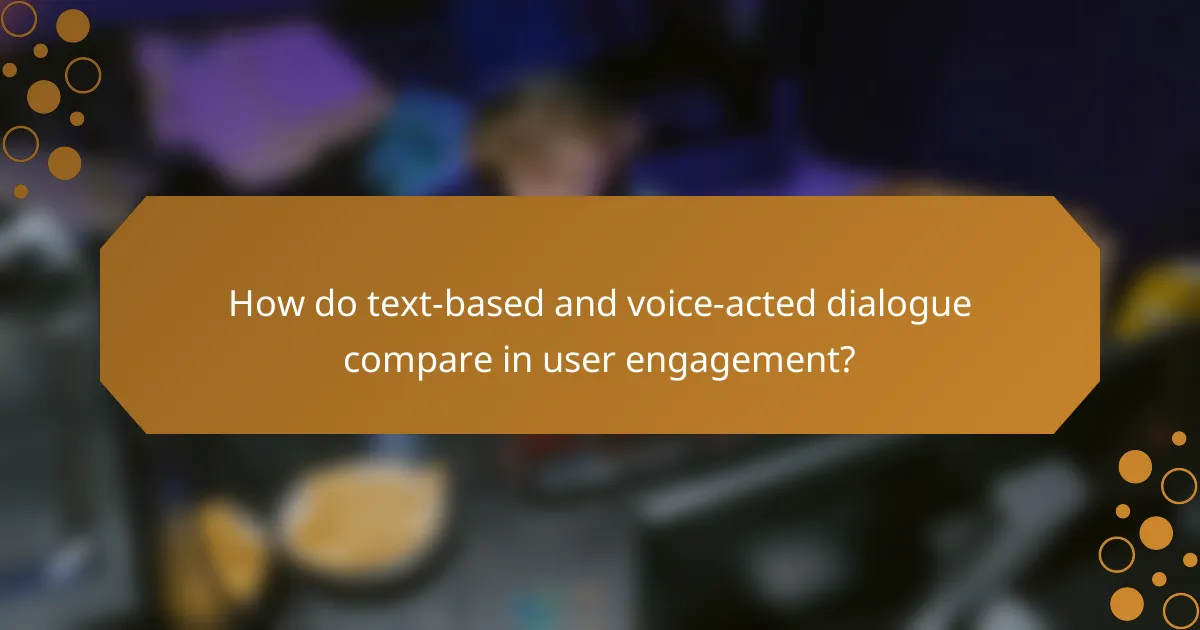
How do text-based and voice-acted dialogue compare in user engagement?
Text-based dialogue provides users with flexibility and control, while voice-acted dialogue fosters a deeper emotional connection. Each method has its strengths and is suited for different contexts, affecting user engagement in unique ways.
Text-based offers flexibility
Text-based dialogue allows users to engage at their own pace, making it easier to revisit previous sections or skip ahead. This format is particularly beneficial in scenarios where users may need to multitask or prefer to read in a quiet environment.
Additionally, text can be easily translated into various languages, accommodating a broader audience. Users can also customize their reading experience through font size and background color, enhancing accessibility.
Voice-acted enhances connection
Voice-acted dialogue creates an immersive experience that can convey emotions and nuances more effectively than text. The tone, inflection, and pacing of a voice actor can bring characters to life, making the interaction feel more personal and engaging.
This method is especially impactful in storytelling or educational contexts, where emotional resonance can enhance retention and understanding. However, it may require users to focus more intently, which could be a drawback in environments where distractions are prevalent.
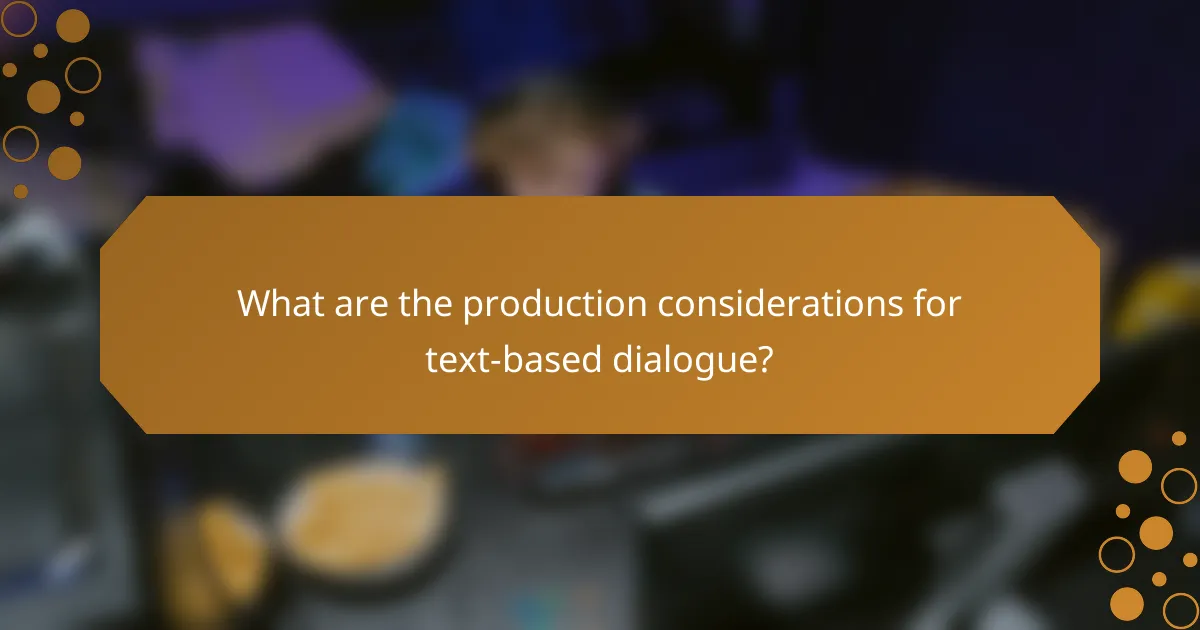
What are the production considerations for text-based dialogue?
Production considerations for text-based dialogue include scriptwriting, formatting, and the tools used for implementation. These factors significantly impact the efficiency and effectiveness of dialogue delivery in various media, such as video games and interactive storytelling.
Scriptwriting and formatting
Effective scriptwriting for text-based dialogue requires clarity and conciseness. Writers should focus on creating engaging and relatable characters while ensuring that the dialogue flows naturally. Formatting is equally important; using clear indicators for speaker changes and appropriate punctuation can enhance readability.
Consider employing a standard format, such as using character names followed by their dialogue in a new line. This approach helps maintain organization and allows for easy navigation through the script. Additionally, incorporating cues for tone or emotion can provide context for actors or developers during implementation.
Software tools for implementation
Choosing the right software tools for implementing text-based dialogue is crucial for seamless integration into projects. Popular tools include game engines like Unity or Unreal Engine, which offer built-in support for text dialogue systems, as well as dedicated dialogue management software like Twine or Ink.
When selecting tools, consider factors such as ease of use, compatibility with your project, and the ability to handle localization if needed. It’s beneficial to test a few options to determine which best suits your workflow and project requirements, ensuring that the dialogue is implemented efficiently and effectively.
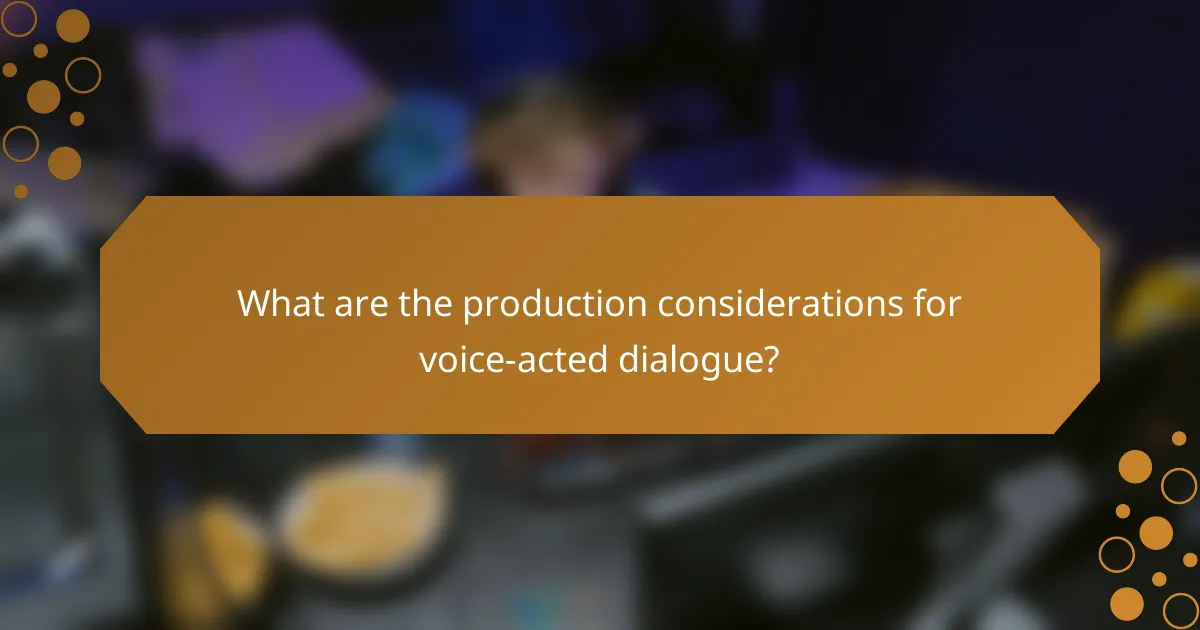
What are the production considerations for voice-acted dialogue?
Producing voice-acted dialogue involves several key considerations, including the selection of voice talent, recording quality, and post-production editing. Each of these factors can significantly impact the overall effectiveness and quality of the final product.
Voice talent selection
Choosing the right voice talent is crucial for effective voice-acted dialogue. Consider the character’s personality, the target audience, and the emotional tone of the project when selecting a voice actor. A well-suited voice can enhance the narrative and engage listeners more effectively.
When evaluating potential voice actors, listen for vocal qualities such as clarity, tone, and expressiveness. It may be beneficial to conduct auditions or listen to demo reels to assess how well the actor can embody the character. Aim for a diverse range of voices to find the best fit for your project.
Recording quality
High recording quality is essential for voice-acted dialogue to ensure clarity and professionalism. Use a soundproof environment and high-quality microphones to capture the voice accurately. Background noise and poor acoustics can detract from the listener’s experience.
Consider using digital audio workstations (DAWs) for recording, as they offer tools for editing and enhancing audio quality. Aim for a recording level that avoids distortion, typically peaking around -6 dB to -3 dB. Regularly monitor recordings to catch issues early.
Post-production editing
Post-production editing is where voice-acted dialogue is polished and refined. This process includes removing unwanted sounds, adjusting volume levels, and adding effects if necessary. Proper editing can significantly improve the overall flow and coherence of the dialogue.
Utilize software tools to enhance the audio, such as equalization and compression, to ensure a balanced sound. It’s also important to maintain consistency in tone and pacing throughout the dialogue. Consider seeking feedback from others during this stage to identify areas for improvement.
